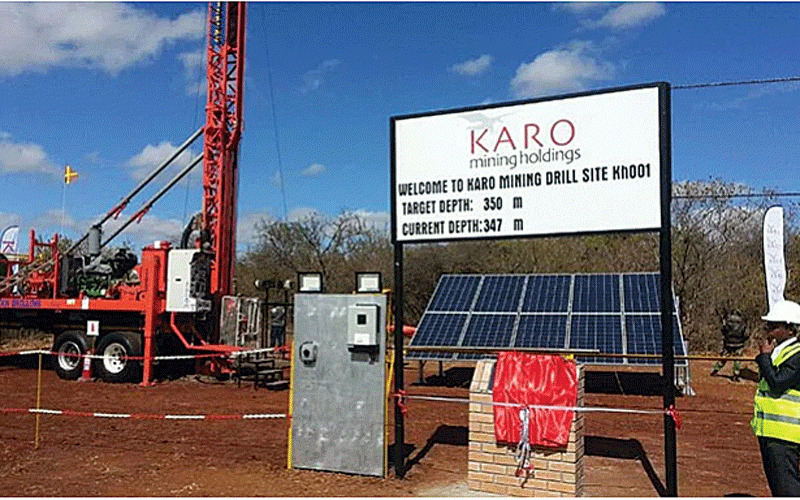
BY SELINA ZHUWARARA
THE commitment by the government of Zimbabwe to formalise and regulate the artisanal mining sector is a solid step in facilitating inclusive and broad-based development.
It is trite that artisanal operators continue to cement their place in the mining industry as they steadily grow in extent and impact every year.
However, the sector’s growth has not been met with the same pace in the development of effective regulation over its activities.
Following the same, the continued negative impacts of the sector have taken precedence in shaping perceptions towards artisanal mining and compounding the task of creating a sustainable solution for the sector.
Notwithstanding the same, it is essential to emphasise the continued need to find solutions to assist artisanal mining in transitioning into a safe, viable and sustainable vocation for those who wish to participate in the mining industry.
One such issue which is critical to the successful integration of the sector into the formal economy is the development of an effectively regulated artisanal mining market.
Whilst many challenges bedevil the artisanal mining sector, the vulnerability of the sector to market uncertainty plays a significant role in the continued informal state of existence and poverty that has become characteristic of the sector.
- Chamisa under fire over US$120K donation
- Mavhunga puts DeMbare into Chibuku quarterfinals
- Pension funds bet on Cabora Bassa oilfields
- Councils defy govt fire tender directive
Keep Reading
The flaccid condition of small-scale markets is a common challenge many economies, in the mining sector, the small-scale chrome miners have consistently advocated for better regulation of the chrome market in Zimbabwe.
They have continuously highlighted the challenges and vulnerability in off-take pricing that constantly undermine their efforts and the need for a dedicated policy and better regulation to be effected in order to manage these vulnerabilities.
There is a general need to restructure small-scale markets to intentionally position them for growth and commercial sustainability in this case, it is important to examine how the artisanal and small-scale mining sector can be improved for meaningful growth.
It is common in many artisanal mining host countries for the artisanal minerals market to be poorly regulated, to have multiple unregulated or poorly regulated dealers/traders/middlemen and for the market to be completely unregulated in some instances.
It is critical for the artisanal minerals market to become regulated and organised around a government-led system, especially in the initial phases of formalisation.
It is a considered view that the disaggregation of the artisanal minerals market must be addressed if the efforts of formalisation is to be successful.
Artisanal mining can only become commercially and economically sustainable when miners receive fair value for their product and efforts.
The guarantee of a fair, predictable and sustainable market structure would enable artisanal miners’ activities to fall within a defined value chain structure that is easier to manage and for government to have influence over the primary value chain steps.
Furthermore, the certainty of structure and order in critical activities such as off-take enables governments to formulate a viable blueprint for the sector’s regulation.
It provides the regulator with identifiable and determinable processes where checks and balances can be successfully introduced.
To this end, governments must prioritise the development of defined market structures for how artisanal minerals can be bought, traded and handled once mined.
It is trite that the difficulties faced by artisanal miners in accessing markets, their low production volumes and the vulnerability caused by illegality significantly erode the bargaining power of artisanal miners.
In more cases than not, miners are prone to arbitrary pricing distortions, such as experienced during the onset of the Covid-19 pandemic.
When the initial national lockdowns were instituted globally, artisanal commodity buyers/dealers capitalised on the increased difficulty of access to markets.
As a result, traders and dealers offered lower spot prices, especially in the gold sector.
The level of vulnerability experienced by artisanal miners consequently perpetuates the cycle of strained capital, poor liquidity and poverty in the artisanal mining sector.
The formalisation of the artisanal mining sector inevitably requires significant regulatory protections to be afforded in the trade framework of the sector before the sector can be able to hold its own.
The most viable way of attaining such insight would be to house the trade of artisanally mined minerals under government-led systems.
Depending on the extent and prevailing structure of the artisanal mining sector in a given jurisdiction, governments need to position themselves as direct and sole aggregators or as primary facilitators in the aggregation of the sectors produce.
A direct and exclusive aggregation role would entail a closed system where the government is solely responsible for sourcing and aggregating all artisanally mined minerals for onward sale.
This approach inevitably eliminates the participation of other buyers and dealers within the sector.
The main advantage of such an approach is that it gives regulators complete oversight of the market and allows the government to better plan and manage the artisanal mining sector.
However, its main disadvantage is that the artisanal mining sector has already evolved and matured with the participation of private buyers and dealers.
The sudden elimination of private buyers may spur the artisanal black market and face resistance, especially where the government buying system is not deemed favourable or is too cumbersome in its procedures.
The sole mandate approach also limits the potential participation and integration of different roles that ordinary citizens can take up within the artisanal mining value chain.
On the other hand, the facilitating aggregator approach would entail a market that accommodates and licences private buyers and traders to buy artisanal minerals with the guidance of a centralised government trade system or platform.
The main advantage of this approach is that the integration and formalisation of existing players such as private buyers and traders is an inclusive approach that is likely to get support from the sector’s value chain.
It also allows regulated competition amongst the buyers, which scenario would stand to benefit artisanal miners.
However, a disadvantage of such an approach would mainly lie in the workforce and resources required to establish effective oversight over multiple dealers and traders.
In addition, such a system would require well-crafted criteria on the vetting and licensing of private traders as well as sufficient mechanisms of oversight to ensure that all trading occurs on the designated system.
It is important to note that the successful aggregation of products produced by the artisanal sector requires artisanal mining host governments to establish effective control over the sector.
This inevitably requires significant resources and manpower to be deployed to give effect to formalisation efforts coupled with the provision of a distinct regulatory framework that brings the sector’s operations into full view.
- Selina Zhuwarara is a policy, governance and sustainability consultant in the mining industry. She has over 10 years’ experience in the mining sector and focuses her efforts on the development of progressive policy and regulation of the artisanal mining sector in Africa.










